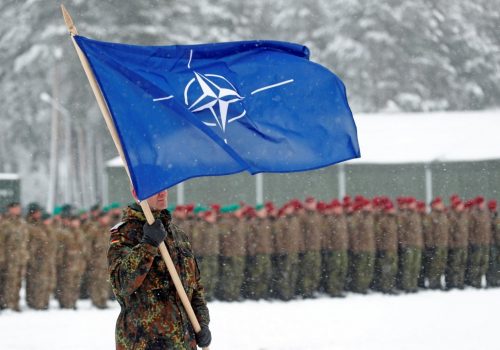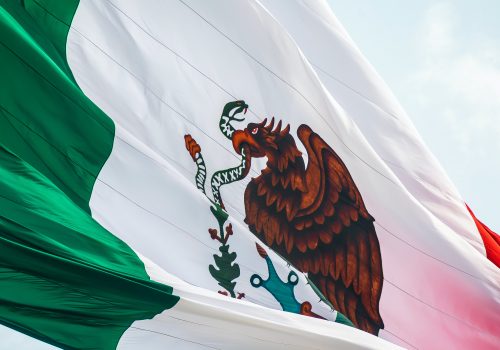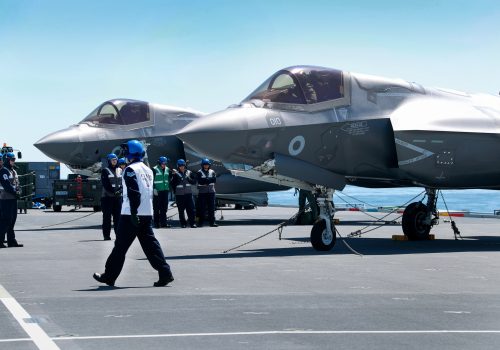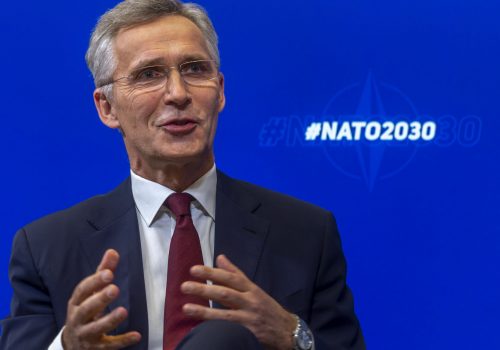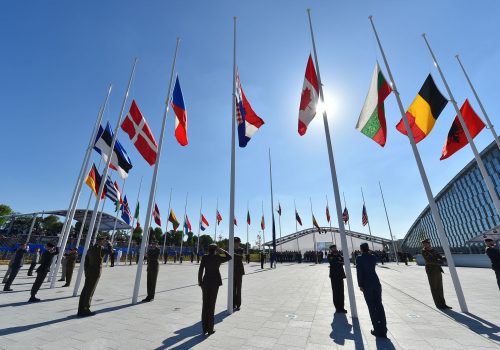Seek membership for Mexico
Donald J. Trump’s presidency has upended the assumption that NATO could count on support from the US commander in chief. The challenge Trump poses to the orthodoxy around the Alliance is part personal, part political, and part reflective of changing attitudes among the US public about foreign and defense policy. It also resonates, in substance if not style, with aspects of the presidencies of Barack Obama and George W. Bush, where NATO was sometimes regarded as a burden to carry rather than an asset to wield.
While this state of affairs might be dismissed as circumstantial to each administration, the questioning of NATO’s centrality to US security interests should be viewed as a trend with underlying structural rationales linked to public sentiment. Like the proverbial boiling frog, progressive US detachment from NATO might result in a sudden decoupling from the Alliance—a situation NATO could not survive and which by multiple accounts almost happened at NATO’s Brussels Summit in 2018.1 Julia E. Barnes and Helene Cooper, “Trump Discussed Pulling U.S. From NATO, Aides Say Amid New Concerns Over Russia,” New York Times, January 14, 2019, https://www.nytimes.com/2019/01/14/us/politics/nato-president-trump.html. For Europeans who view US security guarantees as critical to their sovereignty and for those in the United States who believe the US alliance system is the sine qua non of its power and influence globally, there is an urgent confluence of purpose to rekindle Washington’s fundamental commitment to NATO.
Eventual Mexican membership in NATO may be a necessary ingredient for keeping the United States invested in European security over the long term.2While Article 10 of the Washington Treaty limits NATO membership to European nations, with the backing of NATO’s members, this can be overcome through accession protocols, which have been used routinely in NATO’s history to amend the treaty or to make necessary exceptions. Geographically, Mexico is roughly as equidistant to the North Atlantic area as longtime Alliance member Turkey, while a significant part of Mexican territory lies above the Tropic of Cancer, the southern demarcation line for North Atlantic territory in the Washington Treaty. This suggestion is made with an eye toward the reality that economic3By our own calculations, using data from the International Monetary Fund and the Bureau of Economic Analysis at the US Department of Commerce, California, Texas, and Arizona in combination are the world’s third-largest economy by GDP. and political4Kristen Bialik, “For the Fifth Time in a Row, the New Congress is the Most Racially and Ethnically Diverse Ever,” Pew Research Center, February 8, 2019, https://www.pewresearch.org/fact-tank/2019/02/08/for-the-fifth-time-in-a-row-the-new-congress-is-the-most-racially-and-ethnically-diverse-ever/. power in the United States is shifting to places and populations with fewer traditional ties to Europe such that broadening NATO’s appeal to a diversifying US public is imperative.
The case for diversifying US public support for NATO
The idea that Mexico is the key to keeping the United States committed to an Alliance whose main business is deterring Russian aggression in Europe is admittedly counterintuitive. It also requires an assessment of why this would be an attractive option for Mexico and of what Mexico would bring to the Alliance in practical terms; there are compelling, if inconclusive, arguments on both counts.
Our argument starts from the premise that NATO is foundational to US global leadership such that making it relevant to emerging communities in the United States is compulsory if the Alliance is to earn their political allegiance. It also supposes that sustaining support for NATO must be more than an exercise in public diplomacy, even if that is a necessary element. Instead, ensuring US public support for the Alliance must be grounded in policies that matter to an increasingly diverse and empowered segment of the citizenry.
Making these policies relevant to a broad swath of the US public is especially tricky in a country as expansive as the United States. Regional divergences, ethnic and racial diversity, and political polarization make monolithic solutions impractical. Indeed, Russian malfeasance—including direct interference in US elections—is not the broad-based, animating concern it was when Moscow’s Cold War nuclear arsenal was an omnipresent concern for everyone. It is possible a US-China long-term competition could serve as a general rallying cause, but NATO’s role in such a scenario is uncertain since European publics do not feel threatened militarily by China.
Instead, an enduring US commitment to NATO is more likely to be secured by a variety of policies or missions that reflect the security interests of a diversifying US public. These undoubtedly must include deterrence of Russia—such policies must be germane to European publics as well—but might also require combatting nontraditional threats, such as pandemics and climate change, that are increasingly important to younger citizens.5Harvard Kennedy School Institute of Politics, “Harvard Youth Poll,” April 23, 2020, https://iop.harvard.edu/youth-poll/
harvard-youth-poll; NATO Secretary General Jens Stoltenberg gave a keynote address to university students across ten NATO countries at a seminar on climate and security, where he emphasized that NATO must do its part in controlling climate change. NATO (North Atlantic Treaty Organization), “Secretary General: NATO Must Help to Curb Climate Change,” September 28, 2020, https://www.nato.int/cps/en/natohq/news_178372.htm?selectedLocale=en. However, regional interests will remain an important part of the puzzle as well.
Just as attentiveness to the security of European allies has been a prerogative for generations of Americans with European lineage—which have heretofore dominated political and economic power in the United States—it makes sense that citizens of other backgrounds will be compelled by the security concerns of their familial homelands. For NATO, this might eventually mean more prominent roles in addressing security in Africa or Asia.6African Americans and Asian Americans represent just over 13 percent and 6 percent of the US population, respectively. United
States Census Bureau, “QuickFacts,” accessed October 10, 2020, https://www.census.gov/quickfacts/fact/table/US/IPE120219 But first, the interests of the Hispanic/Latinx7The word “Latinx” is a relatively new term used to most inclusively identify the Hispanic and Latino community. “Hispanic” traditionally refers to an individual of a Spanish-speaking background, including from Spain, residing in the United States. “Latino” generally denominates an individual of Latin American or Caribbean background. To clarify the confusing overlap between the two terms and offer a gender-neutral alternative, “Latinx” is increasingly used as a politically correct pan-ethnic alternative, although it has not been widely adopted. For the purposes of this essay, Hispanic and Latinx have been used interchangeably or in combination as necessitated by the reference material. Mark Hugo Lopez, Jens Manuel Krogstad, and Jeffrey S. Passel, “Who Is Hispanic?” Pew Research Center, September 15, 2020, https://www.pewresearch.org/fact-tank/2020/09/15/who-is-hispanic/. community should take priority, not least because formalizing a relationship between Mexico and NATO is an attainable policy goal.
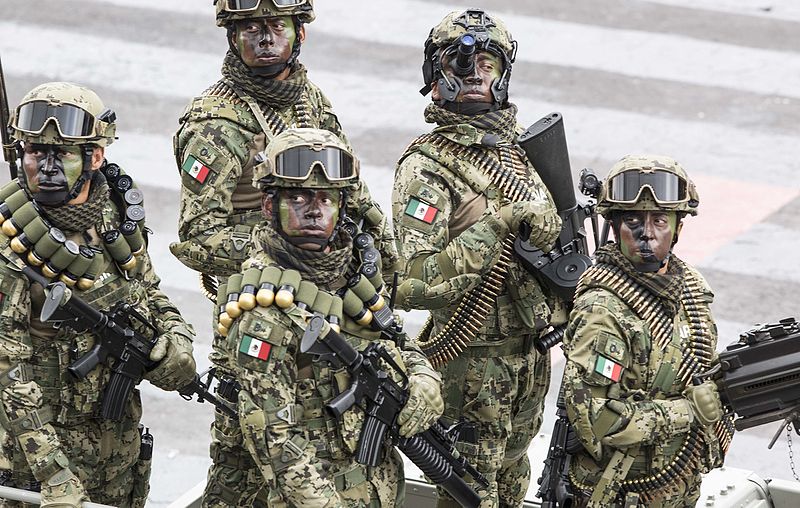
Just as attentiveness to the security of European allies has been a prerogative for generations of Americans with European lineage—which have heretofore dominated political and economic power in the United States—it makes sense that Americans of other backgrounds will be compelled by the security concerns of their familial homelands.
Mexican troops on parade on September 16, 2015 (Source: Wikimedia Commons)
Domestic demographic trends in the United States support this logic as well. According to the Pew Research Center, the US Hispanic/Latinx population reached 60.6 million in 2019, making up 18 percent of the total US population.8Luis Noe-Bustamante, Mark Huge Lopez, and Jens Manuel Krogstad, “U.S. Hispanic population surpassed 60 million in 2019, but growth has slowed,” Pew Research Center, July 7, 2020, https://www.pewresearch.org/fact-tank/2020/07/07/u-s-hispanic-population-surpassed-60-million-in-2019-but-growth-has-slowed/. Of that number, people of Mexican origin account for 62 percent of the nation’s overall Latinx population or some 37 million people. Between 2010 and 2019, the Latinx community accounted for more than half of all US population growth, even as that growth has begun to slow. Overall, Latinx people are the country’s second-largest ethnic group, behind white non-Hispanics.9Jens Manuel Krogstad and Luis Noe-Bustamante, “Key Facts About U.S. Latinos for National Hispanic Heritage Month,” Pew Research Center, September 10, 2020, https://www.pewresearch.org/fact-tank/2020/09/10/key-facts-about-u-s-latinos-for-national-hispanic-heritage-month/; Luis Noe-Bustamante, Mark Hugo Lopez, and Jens Manuel Krogstad, “U.S. Hispanic Population Surpassed 60 Million in 2019, but Growth Has Slowed,” Pew Research Center, July 7, 2020, https://www.pewresearch.org/fact-tank/2020/07/07/u-s-hispanic-population-surpassed-60-million-in-2019-but-growth-has-slowed/.
With the Hispanic/Latinx community projected to comprise 29 percent of the US population by 2050, its views on international relations must be accounted for.10Jeffrey S. Passel and D’Vera Cohn, “U.S. Population Projections: 2005-2050,” Pew Research Center, February 11, 2008, https://www.pewresearch.org/hispanic/2008/02/11/us-population-projections-2005-2050/. While there is limited and conflicted polling data regarding Latinx preferences on foreign policy,11While a 2019 Pew Research Center study found that a minority of Hispanics believe the United States should be active in world affairs, a
2014 Chicago Council of Global Affairs report noted roughly equal preferences between “white” and Latinx support for US global leadership. Pew Research Center, “Large Majorities in Both Parties Say NATO Is Good for the U.S.,” April 2, 2019, https://www.pewresearch.org/politics/2019/04/02/large-majorities-in-both-parties-say-nato-is-good-for-the-u-s/#views-of-u-s-relationship-with-its-allies; Dina S. Smeltz and Craig Kafura, Latinos Resemble Other Americans in Preferences for US Foreign Policy, Chicago Council of Global Affairs, 2015, https://www.thechicagocouncil.org/sites/default/files/Hispanics%20and%20Foreign%20Policy%20-%20Final.pdf. and even less on views toward NATO, anecdotally, it is a low priority. However, a 2014 Chicago Council on Global Affairs study found “that Hispanic Americans are more positive than other Americans toward Mexico. On the scale of ‘feelings’ from 0 to 100, with 100 being the warmest and 50 being neutral, Latinos give Mexico an average rating of 67, compared to an average of 51 among non-Latinos.”12Smeltz and Kafura, Latinos Resemble.
That Mexico’s NATO membership would motivate the US Latinx community to become champions of the Alliance is unknowable short of further research, but it is a reasonable supposition based on the currently available data and common sense. Even a debate about the possibility is likely to introduce NATO to a significant number of US citizens who are otherwise unacquainted with the Alliance, a beneficial outcome in its own right, and one whose effect can be measured. To that end, a structured dialogue between NATO and Mexico to explore a basis for cooperation would be a positive first step.
While NATO membership for Mexico is a generational project requiring a bevy of political and policy incentives to be aligned on all sides, a formal partnership is attainable in the short term. Such a prospect is an opportunity to determine how US Latinx attitudes toward NATO would be impacted while providing the necessary time to work through the practical benefits of eventual membership for both Brussels and Mexico City.
Watch the video
Making the case to Allied capitals
While the central argument of this essay is that European allies should support a formal relationship with Mexico as a means of solidifying long-term US support for NATO, the traditional case for Mexico’s eventual membership is reasonably strong on the merits.
In real and relative terms, Mexico would bring significant resources to the Alliance. Having spent just over $5 billion on defense in 2019, Mexico would rank in the top half of NATO members, even though with defense spending at 0.5 percent of GDP, it would rank last in NATO proportionally.13Marina Pasquali, “Military Expenditure As Percentage of Gross Domestic Product (GDP) in Mexico from 2007 to 2019,” Statista, June 15, 2020, https://www.statista.com/statistics/793995/military-expenditure-share-gdp-mexico/. However, joining the Alliance would assuredly be conditioned on increases to the defense budget such that the $5 billion baseline would come with a built-in upside. With nearly 237,000 active duty personnel, Mexico would be the third-largest military in NATO behind the United States and Turkey, with the army and navy accounting for the preponderance of Mexican end strength.14“Chapter Eight: Latin America and the Caribbean,” Military Balance (2020), 120 (1): 389. To put this in perspective, Mexico’s accession would add more active duty military personnel to NATO’s ranks than the thirteen newest NATO members combined.
While Mexico’s armed forces have more limited competencies than NATO’s highest-end militaries, their capabilities start from a high floor, benefiting from bilateral security cooperation with the United States. As a 2016 Wilson Center study explains, “Over the last decade, the Mexican military has been crafted into a hardened and more professional military, skilled in fourth generation warfare, operating across the spectrum of conflict from surgical small-unit Special Forces missions to division-level stability operations in areas comparable in size to Belgium.”15Iñigo Guevara, A Bond Worth Strengthening: Understanding the Mexican Military and U.S.-Mexican Military
Cooperation, Mexico Institute, Wilson Center, October 2016, https://www.wilsoncenter.org/publication/
bond-worth-strengthening-understanding-the-mexican-military-and-us-mexican-military. Like most new allies or partners, Mexico would not be expected to be a significant contributor to NATO missions immediately, even as the size and aptitude of its armed forces—which have an extensive record of Humanitarian Assistance/Disaster Relief missions worldwide—makes it capable of contributing in theory.16Lt Col Ricardo Reynoso, Mexican Army, “Mexican Humanitarian Assistance System: A Monograph,” School of Advanced Military Studies, United States Army Command and General Staff College, Forth Leavenworth, Kansas, 2016, https://apps.dtic.mil/sti/pdfs/AD1022238.pdf.
Beyond the capability arguments, Mexico could serve as a gateway for an intensified NATO presence in Latin America where the Alliance is absent outside of a formal partnership with Colombia. Given Russia’s criticality in propping up Nicolás Maduro’s regime in Venezuela and China’s growing influence throughout the Global South, an augmented NATO role in Latin America could further democracy promotion while providing a timely deterrent effect, including on Russia’s solicitation of Mexico to increase bilateral trade and security agreements. Moreover, adding a third Pacific country to the Alliance would helpfully advance transatlantic and transpacific linkages with an eye on containing China.
Over time, NATO could use its relationships with Mexico and Colombia to replicate its other regional partnership arrangements, like the Mediterranean Dialogue, to include political consultations for sharing information on local Russian and Chinese activities, and building support for policies on 5G, supply chains, or countering disinformation. In such a context, Brazil’s flirtation with NATO would seem less far-fetched, and other possibilities, like a future democratic Cuba partnering with NATO, would be achievable.
Regardless of the other benefits, European allies would want assurances that Mexico City could be counted on to support decisions related to defense and deterrence in Europe. Even the prospect of keeping the United States committed to the cause of European sovereignty would be less appealing if Mexico were to wield its veto amidst a crisis with Russia, for instance. While such guarantees are hard to imagine at present, they are likely attainable with considered dialogue over time.
Making the case to Mexico City
Longstanding tensions between Mexico City and Washington and historical reluctance from Mexico to impose itself in global security affairs make the notion of Mexico’s membership in a US-led security alliance an ostensible non-starter.17Anvesh Jain, “Canada, NATO, and the ‘Dumbbell Concept,’” NATO Association of Canada,
May 17, 2019, http://natoassociation.ca/canada-nato-and-the-dumbbell-concept/. As a country without a traditional military threat, Mexico is unlikely to need Article 5 protection. In fact, joining NATO might increase risks to Mexico’s security, necessitating military commitments to missions remote from its parochial security concerns while diverting resources toward defense expenditures and away from pressing social needs.
Nevertheless, a formal relationship with NATO would entitle Mexico to enhanced security sector reform (SSR)18Marina Caparini, “Security Sector Reform and NATO and EU Enlargements” in SIPRI Yearbook 2003: Armaments, Disarmaments, and International
Security (Stockholm: Stockholm International Peace Research Institute, 2003), https://www.sipri.org/yearbook/2003/07. from an organization well-versed in the subject; reinforce transatlantic trade relations through consolidation of economic and security interests in tandem with the United States-Mexico-Canada Agreement (USMCA) and the EU-Mexico Global Agreement;19European Union, “Mexico and the EU,” May 12, 2016, https://eeas.europa.eu/delegations/mexico/14897/mexico-and-eu_en. allow it to frame a foreign policy as an even closer partner in North American security on the heels of the USMCA; and underscore its status as a growing regional power20Mexican Defense Secretary Gen. Salvador Cienfuegos and Adm. Vidal Soberón, secretary of the Mexican Navy, signaled Mexican willingness and desire to become more involved in global affairs at the North American Defense Ministerial in 2017. On a bilateral call with both Cienfuegos and Soberón, then-Secretary of Defense Mattis “lauded Mexico’s growing leadership in the region.” “Mattis, Mexican Military Leaders Discuss Bilateral Relationship,” February 8, 2017, DOD News, https://www.defense.gov/Explore/News/Article/Article/1075465/mattis-mexican-military-leaders-discuss-bilateral-relationship/ and influential example for other Latin American states.21David G. Haglund, “Pensando Lo Imposible: Why Mexico Should Be the Next New Member of the North Atlantic
Treaty Organization,” Latin American Policy, October 14, 2010, 1(2): 281.
The most attractive of these factors might be the prestige and status that a NATO affiliation would convey. Despite Mexican President Andrés Manuel López Obrador’s nationalist focus, he shares one goal with his predecessor: securing greater respect for Mexico abroad. A formal association with NATO aligns perfectly with Mexico’s identities and interests as both a North American and Latin American power. Mexico can emphasize its relationship within the North American community, solidifying renewed ties with the United States and Canada through the USMCA. At the same time, membership would fortify Mexico’s currently implied role as a model to other Latin American nations, granting it the opportunity to influence any expanded NATO footprint in the region.
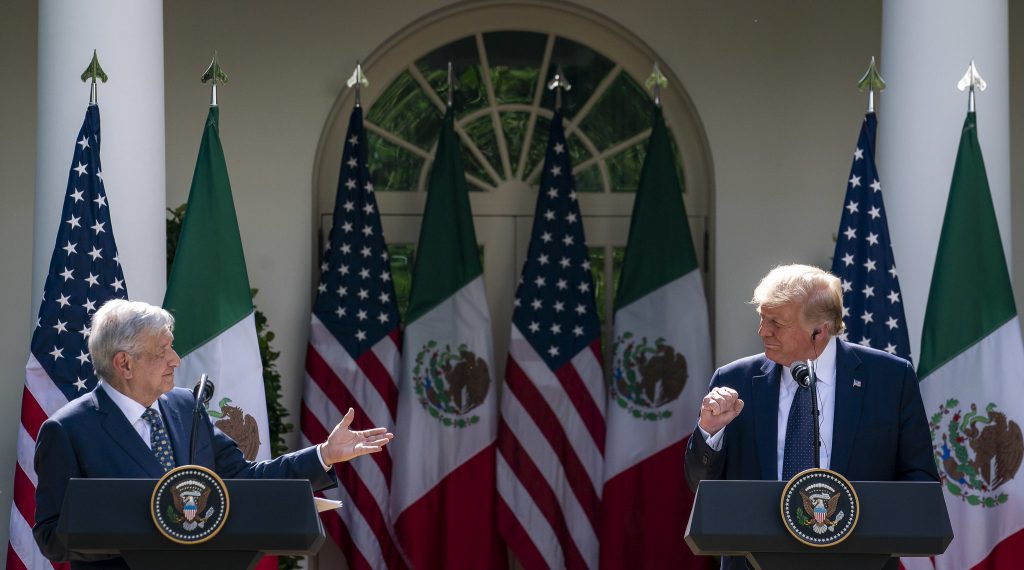
A formal association with NATO aligns perfectly with Mexico’s identities and interests as both a North American and Latin American power.
President Donald J. Trump hosts President of the United Mexican States Andres Manuel Lopez Obrador on July 8, 2020.
(Source: White House Flickr)
Additionally, a number of NATO nations could offer attractive bilateral incentives for Mexico’s participation, including binational US-Canada support to Mexico’s law enforcement and judicial sectors. NATO would serve to both institutionalize and make multilateral existing defense and security dialogues with the United States in ways that might benefit Mexico City practically and politically (and which might be equally welcomed by the US Congress and policy community). NATO might also serve as a backbone for intensified security dialogues with nations, such as Spain and France, with which Mexico already has robust ties.
Finding the right collection of incentives for Mexican citizens and politicians will take time, but there are real options. A number of constituencies—including the Mexican Secretariat of National Defense (Secretaría de la Defensa Nacional, SEDENA), which would realize additional resources and the ability to focus away from internal security to more traditional military tasks—might view a relationship with NATO as an attractive possibility.22Rebecca Bill Chavez, “The Return of Latin America’s Military,” The New York Times Opinion, August 14, 2018, https://www.nytimes.com/2018/08/14/opinion/mattis-latin-americas-military.html.
Conclusion
The US policy community has been focused on shoring up US support for NATO by coaxing European member states to increase burden-sharing contributions. The idea that increased European defense spending would settle US restiveness with NATO misses the point. In fact, the burden-sharing debate is serving as a proxy for underlying demographic realities at the root of waning US support for the Alliance.
While burden sharing is supposed to matter to Trump and his supporters, there is no evidence that even vast increases in European defense spending over the course of the Trump presidency have improved NATO’s standing with the US president or his political base. Rather than attempt to placate those that cannot be appeased, the policy community would be better served by finding new champions for the Alliance.
In discussing this proposal with European colleagues, a common retort is that building NATO’s relationship with Mexico is a distraction from the many security challenges facing Europe. In fact, it may be the key to keeping a rapidly changing United States attuned to those very concerns. It is comparable to a case like Iceland, whose strategic importance (geography) outweighs other types of contributions it can make. For allies that rely on security guarantees from the United States, it should matter little whether Mexico would send forces to an enhanced Forward Presence mission if its membership keeps the United States committed to the cause of European sovereignty.
While the idea of Mexico’s eventual membership in NATO may sound implausible, so did the possibility of Warsaw Pact nations joining the Alliance before circumstances intervened to make it inevitable. As the United States experiences dramatic political upheaval related to rapid demographic realignment, circumstances may again be conspiring to write NATO’s next surprising chapter.
* * *
Christopher Skaluba is the director of the Transatlantic Security Initiative in the Atlantic Council’s Scowcroft Center for Strategy and Security. He previously served as principal director for European and NATO Policy in the Office of the Secretary of Defense.
Gabriela R. A. Doyle is the program assistant in the Transatlantic Security Initiative.
Explore the podcast series
Leer el ensayo en español
Related NATO 20/2020 essays
Related program
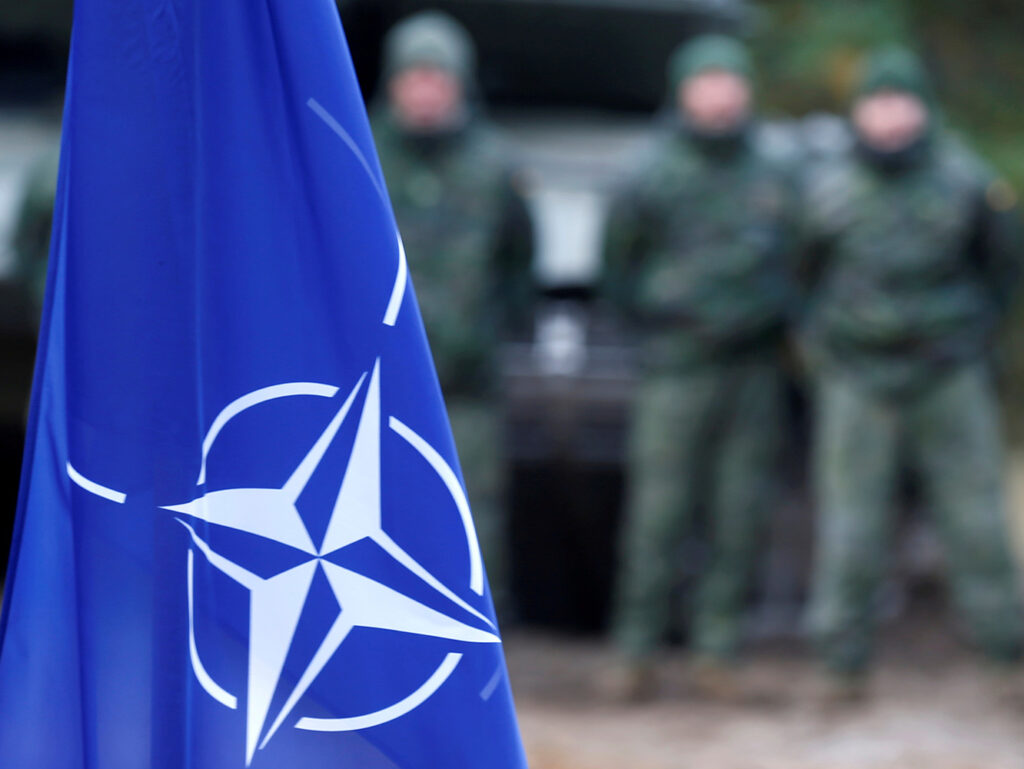
The Transatlantic Security Initiative, in the Scowcroft Center for Strategy and Security, shapes and influences the debate on the greatest security challenges facing the North Atlantic Alliance and its key partners.
Subscribe for events and publications on transatlantic security
Sign up for updates from the Atlantic Council’s Transatlantic Security Initiative, covering the debate on the greatest security challenges facing the North Atlantic Alliance and its key partners.
Image: The Mexican Flag (Source: Unsplash.com)
